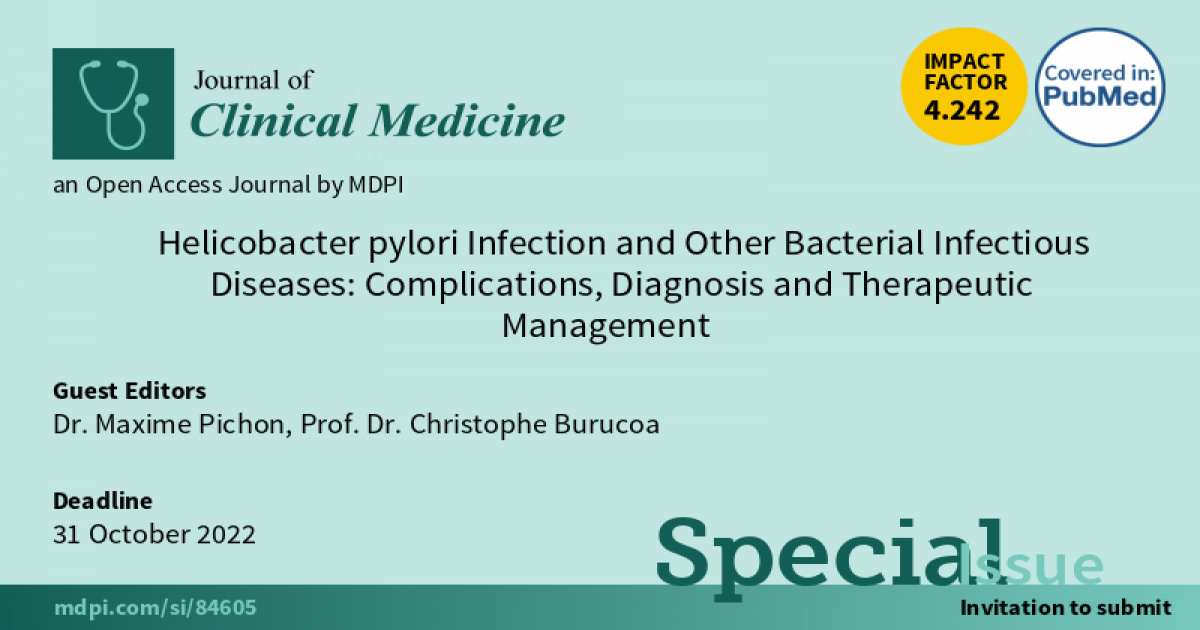Helicobacter pylori Infection and Other Bacterial Infectious Diseases: Complications, Diagnosis and Therapeutic Management
A special issue of Journal of Clinical Medicine (ISSN 2077-0383). This special issue belongs to the section "Infectious Diseases".
Deadline for manuscript submissions: closed (31 October 2022) | Viewed by 14459

Special Issue Editors
2. INSERM U1070 Pharmacology of Antimicrobial Agents, Université de Poitiers, Poitiers, France
3. Université de Poitiers, Faculté de médecine et Pharmacie, Poitiers, France
Interests: clinical microbiology; next-generation sequencing; Helicobacter pylori; antibiotic resistance; bacteriology; translational research
2. INSERM U1070 Pharmacology of Antimicrobial Agents, Université de Poitiers, Poitiers, France
3. Université de Poitiers, Faculté de médecine et Pharmacie, Poitiers, France
Interests: Helicobacter pylori; Antibiotic resistance; diagnosis; epidemiology
Special Issue Information
Dear Colleagues,
Helicobacter pylori (H. pylori) is a bacterium that infects half of the world’s population. Only 10% of the infected people develop a gastric or duodenal ulcer, and, of those, 1–3% of them go on to develop a gastric cancer (adenocarcinoma or MALT lymphoma) that could be considered as very severe (the survival rate is at 5 years for 20%), justifying its recognition as a class 1 carcinogen by WHO. Empirical treatments for eradicating H. pylori infection include a proton pump inhibitor (PPI) in combination with either a bismuth salt and two antibiotics, or three antibiotics, but resistance to these antibiotics is the leading cause of treatment failure. Favored by the significant side effects of combinations of antibiotics, observance is very poor and also promotes the emergence of resistance. The resistance of H. pylori to antibiotics has steadily increased since the discovery of this bacterium in 1982.
This Special Issue of the Journal of Clinical Medicine will cover the following important aspects of the Diagnosis and Therapeutic Management of Helicobacter Pylori infection and its related diseases:
- Diagnosis, pathophysiology and epidemiology of:
- Antimicrobial resistance;
- Gastro-duodenal cancer development.
- Advances in therapeutic management:
- Optimization of antibiotic therapeutic management;
- New approaches in antimicrobial treatment;
- Impact of innovative treatments in gastric environment.
Dr. Maxime Pichon
Prof. Dr. Christophe Burucoa
Guest Editors
Manuscript Submission Information
Manuscripts should be submitted online at www.mdpi.com by registering and logging in to this website. Once you are registered, click here to go to the submission form. Manuscripts can be submitted until the deadline. All submissions that pass pre-check are peer-reviewed. Accepted papers will be published continuously in the journal (as soon as accepted) and will be listed together on the special issue website. Research articles, review articles as well as short communications are invited. For planned papers, a title and short abstract (about 100 words) can be sent to the Editorial Office for announcement on this website.
Submitted manuscripts should not have been published previously, nor be under consideration for publication elsewhere (except conference proceedings papers). All manuscripts are thoroughly refereed through a single-blind peer-review process. A guide for authors and other relevant information for submission of manuscripts is available on the Instructions for Authors page. Journal of Clinical Medicine is an international peer-reviewed open access semimonthly journal published by MDPI.
Please visit the Instructions for Authors page before submitting a manuscript. The Article Processing Charge (APC) for publication in this open access journal is 2600 CHF (Swiss Francs). Submitted papers should be well formatted and use good English. Authors may use MDPI's English editing service prior to publication or during author revisions.
Keywords
- Helicobacter pylori infection
- epidemiology
- gastro-intestinal diseases
- gastric cancer
- treatment
- diagnosis







